The Judgement key is an obvious depiction of Judgement Day. The Hierophant and perhaps The Devil are the other blatantly Catholic major arcana, although most of the keys have a Catholic feel to them. If you lived in Europe in the 15th and 16th centuries when tarot decks were becoming popular you were either Catholic or you were in trouble. The Church had zero tolerance for heretics, and Jews and Muslims were treated like dirt. This was also the time of the infamous European Witch Hunts. So it is not surprising that, even though their message is universal, the designers of the early tarot decks used a Christian theme to make their work more widely accessible. (See previous post on tarot origins)
The death, redemption, and rebirth into a blessed afterlife concept lies at the heart of nearly every religion. It reminds the faithful that there is more to this world than what meets the untrained eye and challenges us to let go of our strangle hold on the material realm. To do this we must release the belief that the more money we make the happier we will be, that the job that is sucking us dry is our only lifeline to a better existence, that everything would be fine if we had just been born into a happy nuclear family, that it makes even one iota of difference what our neighbors think of us, or that we are somehow fatally flawed and unlovable. Each of these convictions clips our wings and traps us in that tiny fragment of the Multiverse called “the material world”. See my previous post on The Devil.
Those are lovely sentiments, you say, but I like this world and I like my creature comforts. And I need to support myself or I’ll be out on a street corner clutching a give-me-money sign and looking pitiful. And even if I do give up all my stuff, how the hell do I escape the material? I’m not ready to die yet.
First off, the goal is not to “escape the material”. We are attached to physical reality just as someone suffering from agoraphobia is attached to his house.
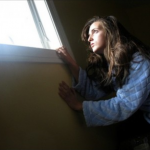 The goal is not to get him to escape his house, but to be comfortable with navigating the outside world and returning home safely. As long as we are “alive” this world is our home, but to be able to live that life more fully we must travel in the other worlds, bring back their wisdom, and apply it. Most of us don’t make it farther than the sidewalk, but I’ve met some amazing people on the sidewalk in front of my house.
The goal is not to get him to escape his house, but to be comfortable with navigating the outside world and returning home safely. As long as we are “alive” this world is our home, but to be able to live that life more fully we must travel in the other worlds, bring back their wisdom, and apply it. Most of us don’t make it farther than the sidewalk, but I’ve met some amazing people on the sidewalk in front of my house.
The makers of the tarot adopted the Judgement Day myth as a metaphor for spiritual awakening, for getting to the sidewalk. The tarot isn’t a guide to the afterlife; it’s a guide to this life.
Notice that Judgement is the second to last card of the major arcana. All the cards before it are mini-lessons about how to get there. If there is a single theme to the tarot it is the lack of communication between the conscious mind, which perceives and comments on the material world and the unconscious mind, which perceives and comments on the outer planes. Our formidable task as human beings is to bring these two parts of ourselves that don’t even speak the same language, let alone view reality in the same way, into useful dialogue.
We see this clearly first in The Lovers (key6), where the man (conscious) is barely looking at the woman (unconscious), who is ignoring him and looking up to the angel, a being on another plane.
When we arrive at The Devil (key 15), despite all the lessons in between, things have deteriorated. Both the man and the woman are now chained to the material world. The woman is staring bleakly ahead and the man looks like he is trying to reason with her—a very poor tactic when dealing with the unconscious. These two have put all their faith in earthly power and money and carefully built themselves a sturdy tower to protect it all. They probably have two fat 401ks and stocks and bonds out the yin yang.
But the divine gives them one last chance. It strikes down that tower with a bolt of lightning and they tumble to earth. (The Tower, key 16)
This is the dark night of the soul and we all must face it at least once in our lives in one form or another. It may be a serious illness or a dream that either scares the shit out of us or dazzles us with its powerful beauty. It may be an initiation, or the loss of a loved one, a limb, our house, our savings, etc. It shatters our psyche and changes our lives to the point where nothing makes sense anymore and we are forced to reexamine all of our previous convictions. Things seem hopeless and we may even wish we were dead.
But if we are strong, we keep on until we see a tiny glimmer of hope (The Star, key 17).
And if we have the courage to follow that star, we arrive in the realm of the unconscious, the vast “Twilight Zone” of The Moon (key 18)
and we learn up close and personal that “There are more things in heaven and earth…Than are dreamt of in (our philosophies).”* With this experience and revelation, the conscious mind can no longer ignore the murmurings of the unconscious, which are becoming louder and clearer. Once we manage to establish a tenuous dialogue between the part of us that is in constant communion with the outer realms and the part of us that understands and operates in this world, things which seemed impossible become possible and the chains that bound us fall away.
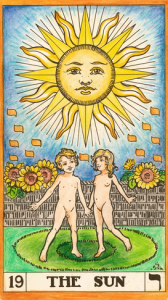
The Sun (key 19) pictures the man and woman transformed into innocent children, holding hands and dancing together. They are now in communication. With this insight comes spiritual awakening (Judgement).
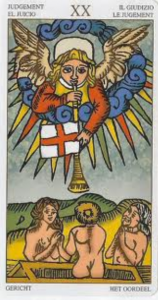
The two children are now integrated into one child, who stands between the man and woman, the conscious and the unconscious, which gave him/her birth. And most importantly, he/she is now facing the angel and completely aware of the clarion call of the divine.
We are all heroes struggling through a life that often seems unreasonably cruel and inscrutable. The tarot was designed to be a guide through the chaos toward enlightenment.
To be continued…..
*The Bard says it all yet again. Hamlet, Act I. Scene V


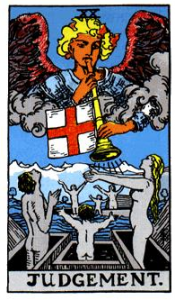
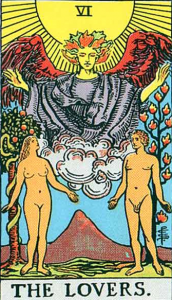
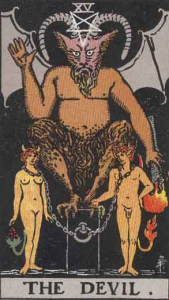
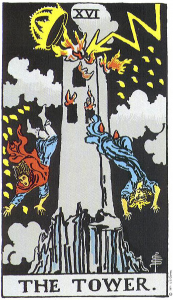
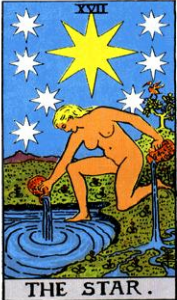
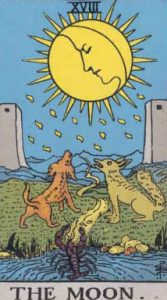
6 thoughts on “Judgement, Part II”
Hi Chrissy. I have been looking forward to this post and the opportunity to examine the Judgement card in a new context. The idea of bringing the unconscious into the material is a theme that really resonates on my path at this moment. In my own life, I’ve found a good deal of peace in striving to see the material as a representation of something bigger. I’m also considering the idea that the something bigger can be very different for each of us. Perhaps, as more and more of us embrace these differences, we will build a richer and more beautiful existence on many, many levels. Thanks for your thought provoking piece. I always look forward to reading what comes next from Chrissy!
Thank you, Rebecca.
I think you’ll enjoy the blog I’m about to post also!
Yes. It’s multi-leveled and multi-faceted. Your higher self is not your human personality and not just your soul. It includes layer upon layer of dimensions. All aspects of the divine abide within you. At the heart of your very nature dwells the higher power (in whatever form you believe that to be), in all its multifarious forms. You’ll experience your higher self in a way that’s suited to you and makes you comfortable. For example, if you happen to be Jewish, you may not want to meet Jesus during your trips to inner space. If you’re Catholic, you may feel uncomfortable meeting Buddha. (But don’t be too surprised if you happen to run across them at some point down the road.) Beyond all your multidimensional aspects there’s an even deeper aspect-the absolute-beyond all forms and phenomena of the material world and even beyond the celestial realm. But now we’re getting ahead of ourselves. We’ll explore more about this later on.
The “beast rising out of the sea” is the selfish animalistic desires that arise which are capable of ruling humanity. These desires spring from the self-will of the unspiritual intellect of humanity whom the world worships as a symbol of material success. The human intellect, lacking spiritual orientation, cuts itself off from all that is divine. The lamb that John sees are the forces of the superconscious mind in the world going into action. “Babylon,” the human desire for earthly riches and success in the gratification of the flesh, begins to be destroyed as humans are shown the consequences of their prostitution of their higher faculties.
So the people in the floating coffins are the beast rising out of the sea?
This is another way of looking at the Judgement card, but we come to essentially the same conclusion.